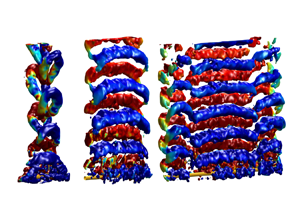Article contents
An experimental study of flow–structure interaction regimes of a freely falling flexible cylinder
Published online by Cambridge University Press: 05 August 2022
Abstract

The fluid–structure interaction problem composed of an elongated, finite-length, flexible cylinder falling in a fluid at rest is investigated experimentally. Tomographic reconstruction of the cylinder and three-dimensional particle tracking velocimetry of the surrounding fluid, based on the Shake-The-Box algorithm, are used jointly to capture both solid and fluid motions. Starting from the rectilinear vertical fall characterized by a steady wake, focus is placed on subsequent regimes involving, mainly in the horizontal direction, periodic rigid-body motions (RBM) of weak amplitude or periodic large-amplitude bending oscillations (BO). Two RBM regimes are explored: the TRA regime where the cylinder exhibits translational oscillations in a plane perpendicular to its axis, and the AZI regime in which the body displays an azimuthal oscillation around its centre. The associated unsteady wakes are composed of counter-rotating vortices bending near the body ends to connect with the adjacent vortex rows. Specific organizations of the vortical structures are uncovered, depending on the regime. In particular, in the AZI regime, they present an antisymmetrical distribution relative to the midspan point. For a sufficiently long cylinder, BO regimes emerge, resembling the structural modes of an unsupported beam. The associated wakes exhibit a cellular organization. Within each cell delimited by two deformation nodes, two counter-rotating vortex rows are shed per oscillation cycle. Flow velocity fluctuations are in phase opposition on each side of a deformation node. For both RBM and BO regimes, frequency and phase analyses of cylinder and wake behaviours, along the span, highlight the spatio-temporal synchronization of the unsteady flow and moving body.
JFM classification
- Type
- JFM Papers
- Information
- Copyright
- © The Author(s), 2022. Published by Cambridge University Press
References
Lorite-Díez et al. supplementary movie 1
\caption{Illustration of the wake pattern and of the cylinder behaviour in a TRA regime with $d = 1.12$mm, $Ar\simeq47$, $Re\simeq49$, $Ca\sim2.6$, and $L/d\simeq35$. Wake is depicted by instantaneous iso-surfaces of the $\lambda_2$ criterion ($\lambda_{2}d^{2}/U^{2} = -0.0004$) colored by iso-contours of the x-vorticity ($\omega_{x}d/U$ $\in [-0.1, 0.1]$; blue to red).}
Lorite-Díez et al. supplementary movie 2
\caption{Illustration of the wake pattern and of the cylinder behaviour in a TRA regime with $d = 1.9$mm, $Ar\simeq103$, $Re\simeq124$, $Ca {\cal O} (10^{-2})$, and $L/d\simeq10$. Wake is depicted by instantaneous iso-surfaces of the $\lambda_2$ criterion ($\lambda_{2}d^{2}/U^{2} = -0.005$) colored by iso-contours of the x-vorticity ($\omega_{x}d/U$ $\in [-0.15, 0.15]$; blue to red).}
Lorite-Díez et al. supplementary movie 3
\caption{Illustration of the wake pattern and of the cylinder behaviour in an AZI regime with $d = 2.55$mm, $Ar\simeq161$, $Re\simeq217$, $Ca {\cal O} (10^{-4})$, and $L/d\simeq20$. Wake is depicted by instantaneous iso-surfaces of the $\lambda_2$ criterion ($\lambda_{2}d^{2}/U^{2} = -0.01$) colored by iso-contours of the x-vorticity ($\omega_{x}d/U$ $\in [-0.2, 0.2]$; blue to red.)}
Lorite-Díez et al. supplementary movie 4
\caption{Bending oscillations of the cylinder during its fall following a M$_1$ regime. }
Lorite-Díez et al. supplementary movie 5
\caption{Illustration of the wake pattern and of the cylinder behaviour in a M$_1$ regime with $d = 1.09$mm, $Ar\simeq45$, $Re\simeq42$, $Ca \simeq 36$, and $L/d\simeq68$. Wake is depicted by instantaneous iso-surfaces of the $\lambda_2$ criterion ($\lambda_{2}d^{2}/U^{2} = -0.0004$) colored by iso-contours of the x-vorticity ($\omega_{x}d/U$ $\in [-0.1, 0.1]$; blue to red).}
Lorite-Díez et al. supplementary movie 6
\caption{Illustration of the wake pattern and of the cylinder behaviour in a M$_2$ regime with $d = 1.02$mm, $Ar\simeq40$, $Re\simeq37$, $Ca \simeq 210$, and $L/d\simeq107$. Wake is depicted by instantaneous iso-surfaces of the $\lambda_2$ criterion ($\lambda_{2}d^{2}/U^{2} = -0.0004$) colored by iso-contours of the x-vorticity ($\omega_{x}d/U$ $\in [-0.1, 0.1]$; blue to red).}
- 4
- Cited by



